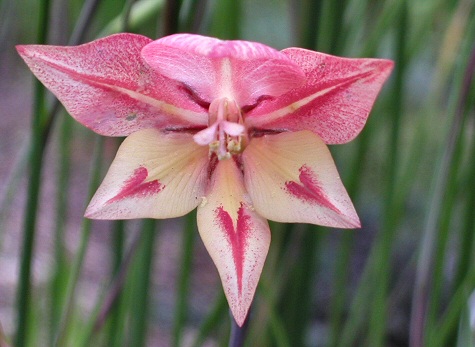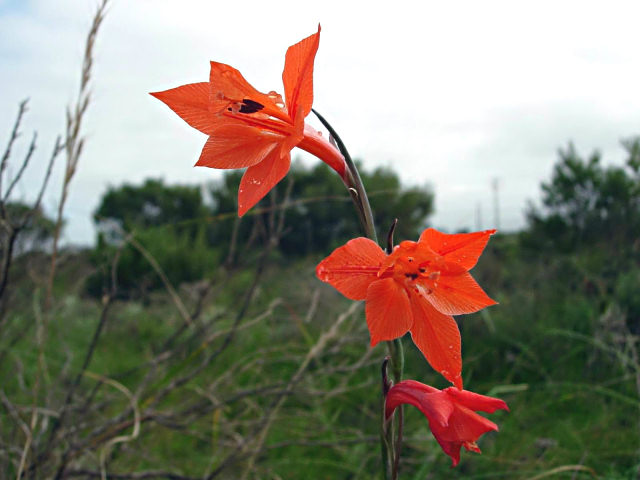When I embarked on this project in September (the diary, not the roof garden), it was my intention to write about the bearded Irises I had been growing, and the Himalayan plants I have been in love with since long before I made the trip to the Tsari valley some 10 years ago.
However, it has evolved, through my exposure to new and exciting plants from all over the world, into something more than that. It had begun to lean towards bulbous plants, perhaps in a year it will be alpines from New Zealand (I hope not!)
At the moment I have taken to South African bulbs, their beauty being surpassed only by their difficulty in cultivation. Lilies, always a favourite, have come to rival the Iris family (juno, oncocyclus and regalia even) for my affection, coming, like the Iris, so easily from seed although taking rather longer to flower!
If every seed in every packet were to germinate, even though many provide fewer than 10 little embryos, there would simply be no room on the roof. That is a bridge I will cross when I come to it. The fact is I am so enamoured by plants there are times when I just have to have it; it's my life's passion, some would say an addiction, and has been since I was a very small child and my mother would give me a small patch in the corner of the veg patch to grow annuals.
The very first things I grew myself rom seed were mixed cacti (in the greenhouse, not the ground). I also remember some compositae thing, it was called a Chrysanthemum then but probably has about eight syllables now, (I think they may have been South African, ironically); and ornamental gourds. When asked what I wanted to be when I grew up I would always answer proudly: "the Queen's gardener".
 |
| At four or five years old I grew chrysanthemums like the ones aobe in my little patch, followed by ornamental gourds (below d'oh!) |
When I was ten we moved to the countryside proper (not just a village but a house with a sprawling garden of about an acre of extremely fertile Angus clay (the area is world famous for its soft fruit and the house is right on the edge of what was a fruit farm. It has since diversified.
The house was the signalman's where two rail lines met, neither of which have operated for 50 years. But that stuff they use to lay the tracks on lasts a lot longer! The garden was completely exposed to the wind and my poor mother planted shrubs and saplings with a pick-axe. Only now are some of the really common ones: Fortsythia, Cotoneaster, Spirea etc, 27 years later, reaching maturity. Ironically, one of the worst performers was that coloniser of railway sidings everywhere, Buddleia davidii!. Here are some images taken today, I'm afraid you can't see much, it has been like this since November here...
 |
| This, honestly, is (was?) Rhododendron Falconeri. It was -10.2C last night |
 |
| Those were "mini" conifers when I planted them, expected to reach 2-3ft in their lifetime and that's a Deutzia of some kind on the left |
So, there we go, that's where it all started. There is a bulb house, where I grew Irises bucharica and Hoogiana, as well as a lot of the really hardcore Lewisias and others that have long been forgotten, a whole greenhouse with louvres down the side, but I'm not ready to go in there yet.
So I dabbled in Himalayan plants; there was a pond below the rock garden and a bog garden with candelabra Primulas sowing themselves all over the place; the bed with the Deutzia contained blue poppies, Paeonia lutea, Roscoea, Daphnes, Cornus Kuosa, Iris bulleyana, I. chrysographes, I. orientalis, I. graminea, I. maackii, I. sibirica, I. prismatica, I. tenuifolia, I. latifolia and many more of the genus... And then I moved to London and everything changed. So far much of the planting list has been largely in keeping with the blurb at the top of the blog. But over the course of a few months that has changed dramatically.
I'ts not that I've taken anything from it, I've just added to it!
I recently won a load of Gladioli on eBay. There is room for these in clay pots on the window sill after the tulips have flopped. However, the vendor had zero transactions so I'm not getting my hopes up about seeing them. Fortunately PayPal will cover me as I paid a lot for them. Assuming they do come, here they are:
 |
| Gladiolus gracilis |
 |
| G. Saundersii (C)Africanbulbs.com |
 |
| G. priorii |
 |
| G. Carmineus |
.jpg) |
| G. brevifolius |















Hi Chris, I think your blog is wonderful, you seem to know a lot about growing rare plants and what you don't know you source from books and the web. It obviously takes about 5 or 6 hours to prepare each post which shows real dedication. Your subject matter is unique too and loads more people should read it. Merry Christmas, Chris
ReplyDeleteHello Chris,
ReplyDeleteI would love to see "the used to be your playground" in the spring. I bet there are lots of spring flowering bulbs beneath that snow. Thanks for the winter tour. And I too bought lot of plants from ebay last fall, mostly native plant. Great post. Hope your Christmas was merry and bright.
BTW, I added a link of your blog to my blog. And thanks for linking my blog to yours.
Thanks Lily! Yes, there are a lot of naturalised narcissus and crocus in the woodland area (nightmare to plant, rock-solid clay!) and Frit meleagris in the orchard, many escapees from the bases of the trees. But dad wants to fill in most of what hasn't already gone so I'll have to be quick if I want to rescue anything. There's a unique orange Turk's cap lily bred by Christies Nursery of Kirriemuir. It didn't have a name when I got it but while there are too many orange turk's caps in the world, this one had huge blooms and bulblets. Good combination!. Thanks again for the link Cx
ReplyDelete